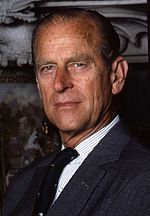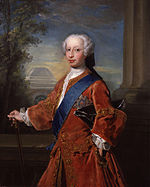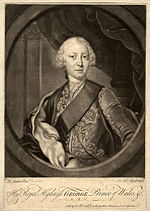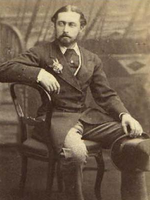- Duke of Edinburgh
-
The Duke of Edinburgh is a British royal title, named after the city of Edinburgh, Scotland, which has been conferred upon members of the British royal family only four times times since its creation in 1726. The current holder is Prince Philip, the royal consort to Elizabeth II.
Contents
History of the title
The title was first created in the Peerage of Great Britain on 26 July 1726 by George I, who bestowed it on his grandson Prince Frederick, who also became Prince of Wales the following year. Upon Frederick's death, the title was inherited by his son Prince George. When Prince George became King George III in 1760, the title "merged into the crown", and ceased to exist.
Four years later, on 19 November 1764, George III created a variation of the title for his younger brother, Prince William, the full form being "Duke of Gloucester and Edinburgh". In 1805, that title was inherited by William's only son, Prince William Fredrick, who died without a male heir, causing the title to cease to exist.
Queen Victoria re-created the title on 24 May 1866 for her second son Prince Alfred, this time in the Peerage of the United Kingdom. When Alfred became the sovereign of the two German duchies Saxe-Coburg and Saxe-Gotha in 1893, he and his five children had to renounce their British titles, so the title ceased to exist again.
The title was created for a third time on 19 November 1947 by George VI, who bestowed it the next day on his son-in-law Lt. Philip Mountbatten, when he married Princess Elizabeth. Earlier that year, Philip had renounced his Greek and Danish royal titles (he was born a Prince of Greece and Denmark, being a male-line grandson of king George I of Greece and male-line great-grandson of king Christian IX of Denmark) along with his rights to the Greek throne. In 1957, Philip became a Prince of the United Kingdom.
Dukes of Edinburgh, first creation (1726-1760)
- Prince Frederick (1707–1751), 1st Duke of Edinburgh (1726–1751). The eldest son of George II, he was created Prince of Wales in 1727 but died before his father.
- Prince George (1738–1820), 2nd Duke of Edinburgh (1751–1760). The eldest son of the first duke, he was created Prince of Wales later in 1751. He succeeded his grandfather as George III in 1760, when the title merged in the crown.
Dukes of Gloucester and Edinburgh (1764-1834)
- Prince William (1743–1805), 1st Duke of Gloucester and Edinburgh (1764–1805). He was the younger brother of George III, who created the title for him.
- Prince William Fredrick (1776–1834), 2nd Duke of Gloucester and Edinburgh (1805–1834). He was the only son of the first duke and died without issue.
Dukes of Edinburgh, second creation (1866-1893)
- Prince Alfred (1844–1900), 1st Duke of Edinburgh (1866–1900). He was the second son of Queen Victoria and Prince Albert, and became the sovereign Duke of Saxe-Coburg and Gotha in 1893. Predeceased by his only son, he died without male issue and the title became extinct.
Dukes of Edinburgh, third creation (1947-)
 HRH The Prince Philip is the current Duke of Edinburgh, and the fourth since the title was first created in 1726.
HRH The Prince Philip is the current Duke of Edinburgh, and the fourth since the title was first created in 1726.
- Prince Philip (1921-), 1st Duke of Edinburgh (1947-). He was bestowed the title when he married the future Elizabeth II (who was thereafter known as the Duchess of Edinburgh until she became queen in 1952). However, he was not bestowed the title "prince" until 1957.
Future dukes
It was announced in 1999, at the time of the wedding of Prince Edward, Earl of Wessex, the youngest son of Queen Elizabeth and Prince Philip, that he would follow his father as Duke of Edinburgh—when that title "eventually reverts to the crown".[1] The process by which this might happen is not simple, and will almost certainly not involve Edward directly inheriting the title from his father.
Like all British dukedoms, the title of Duke of Edinburgh passes to the sons in order of age (i.e. "heirs-male" under standard Salic law succession), unless it merges with the crown; and Edward is currently fifth in this line of succession, following his two elder brothers, Prince Charles and Prince Andrew, and Prince Charles' two sons, Princes William and Harry. Thus, if the present duke dies while his wife is still the monarch, the title will be inherited by his eldest son, Charles, Prince of Wales or Charles' heir William, Duke of Cambridge if he is deceased. Consequently, the Dukedom of Edinburgh can merge with the crown only when Charles (or his heir) has inherited both the dukedom and the throne. The only way that Edward can inherit the title directly from his father is in the very unlikely event of both his elder brothers and both nephews predeceasing the Duke of Edinburgh, or if the Queen grants her husband a second dukedom of Edinburgh with a special remainder to Edward. Special remainders permit successions without the usual rules, such as the inheritance of the second Dukedom of Fife, which passed to Edward VII's granddaughter while the original title became extinct.
Dukes of Edinburgh in fiction
Prince Edmund (Blackadder) (1461–1498) in the BBC historical comedy television series The Black Adder. Rowan Atkinson played the fictional Prince Edmund Plantagenet, Duke of Edinburgh, Laird of Roxburgh, Selkirk and Peebles, Lord Warden of the Royal Privies, Archbishop of Canterbury, who was the illegitimate son of Donald MacAngus, third duke of Argyll and Queen Gertrude of Flanders. Prince Edmund was therefore the stepson of King Richard IV (a fictionalised version of Richard of Shrewsbury, Duke of York); however, his illegitimacy was unknown to the King. He had Scottish titles despite Scotland being a separate kingdom at the time.
See also
- Edinburgh
- The Duke of Edinburgh's Award
- Edinburgh of the Seven Seas
- Prince Edmund (Blackadder), for a fictitious Duke of Edinburgh
- List of dukedoms by reign
References
- ^ "The Earl of Wessex". Royal.gov.uk. http://www.royal.gov.uk/ThecurrentRoyalFamily/TheEarlofWessex/The%20Earl%20of%20Wessex.aspx. Retrieved 2010-10-30.
External links
- HRH The Duke of Edinburgh on Burke's Peerage
- Duke of Edinburgh
Dukes of Edinburgh HRH The Prince Philip, Duke of Edinburgh
Prince Frederick (1726–1751) · George III (1751–1760) · Prince William Henry (1764–1805) · Prince William Frederick (1805–1834) · Prince Alfred (1866-1900)British royal titles King/Queen of United Kingdom (consort), Duke of Lancaster & Duke of Normandy · Duke of Edinburgh · Prince of Wales (Princess), Duke of Cornwall (Duchess) & Duke of Rothesay (Duchess) · Duke of York (Duchess) · Duke of Gloucester · Duke of Kent · Duke of Cambridge · Earl of Wessex · Princess RoyalInactive titles Extant dukedoms in the peerages of the British Isles* Cornwall • Norfolk • Somerset • Richmond • Grafton • Beaufort • St Albans • Bedford • Devonshire • Marlborough • Rutland • Rothesay • Hamilton • Buccleuch • Lennox • Queensberry • Argyll • Atholl • Montrose • Roxburghe • Brandon • Manchester • Northumberland • Leinster • Wellington • Sutherland • Abercorn • Westminster • Gordon • Fife • Gloucester • Kent • Edinburgh • York • Cambridge
* Extant dukedoms, listed by precedence, from highest to lowest
 Categories:
Categories:- Dukes of Edinburgh
- Dukedoms of Great Britain
- British monarchy
- Prince Philip, Duke of Edinburgh
- 1726 establishments in Great Britain
- 1866 establishments in the United Kingdom
- Dukedoms of the United Kingdom
- Lists of dukes in Great Britain
Wikimedia Foundation. 2010.



